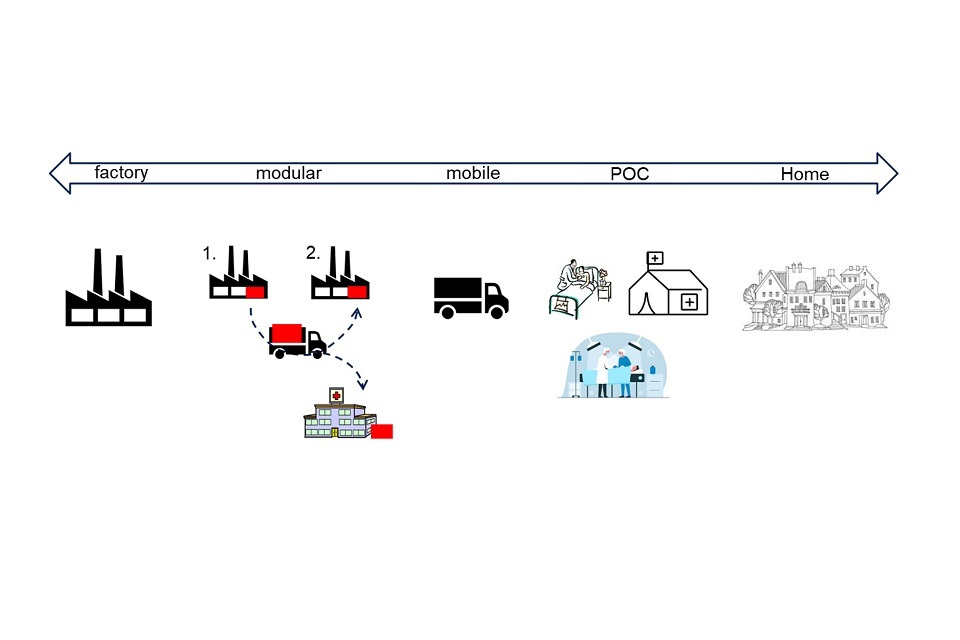Horizon Scanning Case Study: Point of Care manufacture
Horizon scanning at the MHRA leads to a proposed new framework to enable the supply and increase in the availability of innovative new medicinal products made at the point of care to patients.
The Issues
Technology is enabling the creation of new medicinal product types with features such as very short shelf lives, in the range of 30 seconds to a few hours, necessitating manufacturing at the point of care (POC), as well as other highly personalised products. The types of products with these features include Advanced Therapy Medicinal Products (ATMPs), blood products, 3D-printed small molecules and some medical gases.
Through horizon scanning and examining trends in information obtained from requests for regulatory and scientific advice, borderline classification opinions and the presence of some products in clinical trials MHRA identified that there are a wide range of medicinal products in development that will require POC manufacture. The issue with these products is that they do not fit the current ‘standard model’ of manufacture and supply, which typically features centralised manufacture of large batches of stable products at a few manufacturing sites.
The change that is needed
The current legislative framework is geared for the centralised manufacture of medicinal products which, for each product type, is manufactured in a relatively small number of sites each at large scale. This is primarily because the products have a long shelf life and are then distributed globally to a mass market.
Current regulations require each manufacturing site to be named on the Marketing Authorisation and to inspect and authorise each of those sites, horizon scanning identified a need for a new regulatory framework to enable the development of POC manufacture and supply in the UK. This framework will accommodate the needs of medicines products manufacture at POC but will also provide control measures equivalent to those currently in place for medicinal products manufactured in factory-based locations, this will ensure that POC products have appropriate quality, safety, and efficacy attributes.
What the MHRA did
Following internal discussions, we engaged extensively with stakeholders involved in the development, manufacture, testing, clinical trials and licensing of POC products in the UK. We organised workshops in 2020 to explore the technologies and products that are applicable to POC manufacture and the control measures that would need to be established to support their safe development.
In March 2021, we held a stakeholder engagement event with over 50 attendees from across the healthcare sector to build on the learning points from the previous meetings. At this event we presented a high-level view of a proposed regulatory framework for POC manufacture, which is centred on the concept of a Control site. This Control site would be named on clinical trial and marketing authorisation applications and would oversee all aspects of the POC manufacturing system including the individual manufacturing locations and their activities. The proposed regulatory framework is based on and links into current regulatory systems for medicines approvals, clinical trials, evaluation of regulatory compliance at manufacturing sites and safety monitoring.
Based on discussions and feedback from attendees of this event we produced a consultation document, which went out for formal public consultation for 6 weeks in the summer of 2021. Responses were significantly positive and there was positive support for the framework to apply across the full range of manufacturing scenarios, from modular manufacture to home-based manufacture – see diagram below.

Outcomes
Through horizon scanning and review of the regulatory and scientific advice signals received, we identified a need to amend The Human Medicine Regulations 2012 and The Medicines for Human Use (Clinical Trials) Regulations 2004. These changes are required to create a new framework to enable the supply and increase the availability of innovative new medicinal products made at POC to patients.
Legal instructions are being developed to amend these two areas of UK medicines legislation, these changes are made possible by the Medicines and Medical Devices Act 2021. These new Statutory Instruments are due to be laid in Parliament later in 2022. At that time, guidance documents will be developed in consultation with stakeholders.
The UK will be the first country to introduce a tailored framework for the regulation of innovative products manufactured at the point where a patient receives care. MHRA is in discussion with a range of international regulators to support the development of a similar framework in those territories to allow patients to access POC products.
The Ian Rees, the regulatory science expert who is leading on the work for the MHRA said:
This is a clear example of proactive and responsive regulatory action, where the MHRA identified a step-change in approach to medicines development and manufacture that will benefit from and require changes to the regulatory framework.